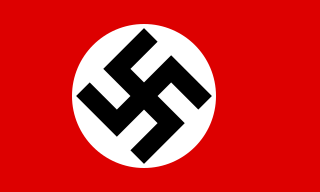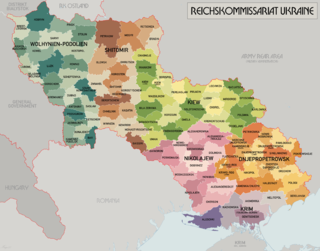 W
WThe Gaue were the main administrative divisions of Nazi Germany from 1934 to 1945.
 W
WThe Military Administration in Belgium and Northern France was an interim occupation authority established during the Second World War by Nazi Germany that included present-day Belgium and the French departments of Nord and Pas-de-Calais. The administration was also responsible for governing the zone interdite, a narrow strip of territory running along the French northern and eastern borders. It remained in existence until July 1944. Plans to transfer Belgium from the military administration to a civilian administration were promoted by the SS, and Hitler had been ready to do so until Autumn 1942, when he put off the plans for the time being. The SS had suggested either Josef Terboven or Ernst Kaltenbrunner as the Reich Commissioner of the civilian administration.
 W
WThe Reichskommissariat of Belgium and Northern France was a Nazi German civil administration (Zivilverwaltung) which governed most of occupied Belgium and northern parts of occupied France in the second half of 1944 during World War II.
 W
WBialystok District was an administrative unit of Nazi Germany created during the World War II invasion of the Soviet Union. It was to the south-east of East Prussia, in present-day northeastern Poland as well as in smaller sections of adjacent present-day Belarus and Lithuania.
 W
WThe German-occupied territory of Montenegro was the area of the Italian governorate of Montenegro occupied by German forces in September 1943, after the Armistice of Cassibile; in which the Kingdom of Italy capitulated and joined the Allies. Italian forces retreated from the governorate, and from neighbouring Albania. German forces occupied Montenegro, along with Albania, and the territory remained under German occupation until Axis forces evacuated in December 1944.
 W
WThe Reichskommissariat Niederlande was the civilian occupation regime set up by Germany in the German-occupied Netherlands during World War II. Its full title was the Reich Commissariat for the Occupied Dutch Territories. The administration was headed by Arthur Seyss-Inquart, formerly the last chancellor of Austria before initiating its annexation by Germany.
 W
WThe Reichskommissariat Norwegen was the civilian occupation regime set up by Nazi Germany in German-occupied Norway during World War II. Its full title in German was the Reichskommissariat für die besetzten norwegischen Gebiete. It was governed by Reichskommissar Josef Terboven until his deposition on 7 May 1945. The German military forces in Norway, then under the command of general Franz Böhme, surrendered to the Allies on 9 May and the legal government was restored.
 W
WA Reichsgau was an administrative subdivision created in a number of areas annexed by Nazi Germany between 1938 and 1945.
 W
WReichskommissariat is the German designation for a type of administrative entity headed by a government official known as a Reichskommissar. Although many different such offices existed primarily throughout the Imperial German and Nazi periods in a number of different fields it is most commonly used to refer to the quasi-colonial administrative territorial entity established by Nazi Germany in several occupied countries during World War II. While officially located outside the German Reich in a legal sense, these entities were directly controlled by their supreme civil authorities, who ruled their assigned territories as German governors on behalf of and as direct representatives of Adolf Hitler.
 W
WReichskommissariat Don-Wolga, literally "Reich Commissariat Don-Volga", was a theoretical civilian occupation regime of Nazi Germany discussed during the early stages of German planning for its occupation of territories in the Soviet Union, one of several other Reichskommissariats. It is also referred to in German memoranda as simply the Dongebiet.
 W
WThe Reichskommissariat Kaukasus, also spelled as Kaukasien, was the theoretical political division and planned civilian occupation regime of Germany in the conquered territories of the Caucasus during World War II. Unlike the other four planned Reichskommissariats, within the borders of the proposed Caucasus Reichskommissariat experiments were to be conducted for various forms of autonomy for "indigenous groups".
 W
WReichskommissariat Moskowien, also spelled as Moskau, literally "Reich Commissariat of Muscovy ", was the civilian occupation regime that Nazi Germany intended to create in central and northern European Russia during World War II, one of several similar Reichskommissariat. It was also known initially as the Reichskommissariat Russland. Siegfried Kasche was the projected Reichskomissar, but due to the German failure to occupy the territories intended to form the Reichskommissariat, it remained on paper only.
 W
WReichskommissariat Turkestan was a projected Reichskommissariat that Germany proposed to create in the Central Asian Republics of the Soviet Union in its military conflict with that country during World War II. Soviet historian Lev Bezymenski claimed that names Panturkestan, Großturkestan and Mohammed-Reich were also considered for the territory.
 W
WThe Territory of the Military Commander in Serbia was the area of the Kingdom of Yugoslavia that was placed under a military government of occupation by the Wehrmacht following the invasion, occupation and dismantling of Yugoslavia in April 1941. The territory included only central Serbia, with the addition of the northern part of Kosovo, and the Banat. This territory was the only area of partitioned Yugoslavia in which the German occupants established a military government. This was due to the key rail and riverine transport routes that passed through it, and its valuable resources, particularly non-ferrous metals. On 22 April 1941, the territory was placed under the supreme authority of the German military commander in Serbia, with the day-to-day administration of the territory under the control of the chief of the military administration staff. The lines of command and control in the occupied territory were never unified, and were made more complex by the appointment of direct representatives of senior Nazi figures such as Reichsführer-SS Heinrich Himmler, Reichsmarschall Hermann Göring, and Reichsminister Joachim von Ribbentrop. The Germans used Bulgarian troops to assist in the occupation, but they were at all times under German control. Sources variously describe the territory as a puppet state, a protectorate, a "special administrative province", or describe it as having a puppet government. The military commander in Serbia had very limited German garrison troops and police detachments to maintain order, but could request assistance from a corps of three divisions of poorly-equipped occupation troops.
 W
WRegierungsbezirk Zichenau was a Regierungsbezirk, or administrative region, of the Nazi German Province of East Prussia in 1939–45. It is also referred to as South East Prussia. The regional capital was Zichenau (Ciechanów).